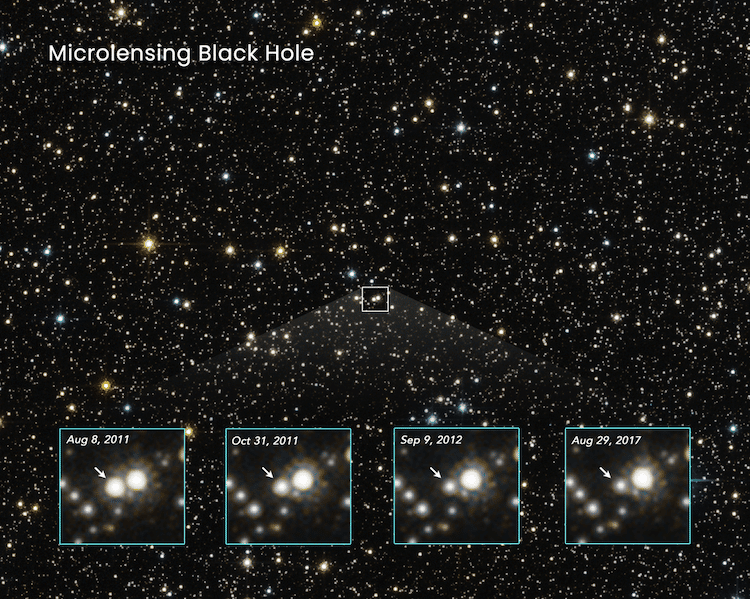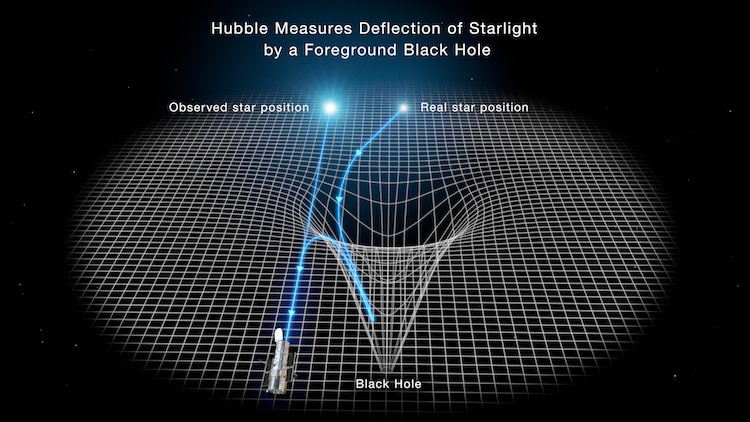Concept illustration of wandering black hole.
And after more than 30 years, it continues to impress.
Usually, black holes sit at the center of a galaxy or are paired with associated stars.

Concept illustration of wandering black hole. (Credit: FECYT, IAC)
These stars explode as supernovae, and the remnant core is crushed by gravity into a black hole.
Either way, it’s an exciting discovery.
The star-filled sky in this Hubble Space Telescope photo is located in the direction of the galactic center.

The star-filled sky in this Hubble Space Telescope photo is located in the direction of the galactic center. The brightness of stars are monitored to see if any change in apparent brightness is made by a foreground object drifting in front of them. The warping of space by the interloper would momentarily brighten the appearance of a background star, due to an effect called gravitational lensing. One such event is shown along with the four close-up frames at the bottom. The arrow points to a star that momentarily brightened, as first captured by Hubble beginning in August 2011. This was caused by a foreground black hole drifting in front of the star, along our line of sight. The star brightened and then subsequently faded back to its normal brightness as the black hole passed by. Because a black hole doesn’t emit or reflect light, it cannot be directly observed. But its unique thumbprint on the fabric of space can be measured through these so-called microlensing events. Though an estimated 100 million isolated black holes roam our galaxy, finding the telltale signature of one is a needle-in-haystack search for Hubble astronomers.(Photo: NASA, ESA, and Kailash Sahu (STScI); Image Processing: Joseph DePasquale (STScI))
One such event is shown along with the four close-up frames at the bottom.
The arrow points to a star that momentarily brightened, as first captured by Hubble beginning in August 2011.
The star brightened and then subsequently faded back to its normal brightness as the black hole passed by.

Illustration revealing how the gravity of a black hole warps space and bends the light of a distant star behind it. A black hole is the crushed remnant of a massive star that exploded as a supernova. The black hole traps light due to its intense gravitational field, hence it cannot be seen directly. The black hole distorts the space around it, which warps images of stars lined up almost directly behind it. This offers telltale evidence for the existence of lone black holes wandering our galaxy. The light from a background star is deflected and brightened by the black hole’s intense gravitational field. The Hubble Space Telescope goes hunting for these black holes by looking for distortion in starlight as the black hole drifts in front of background stars.(Photo: NASA, ESA, STScI, Joseph Olmsted)
Because a black hole doesn’t emit or reflect light, it cannot be directly observed.
But its unique thumbprint on the fabric of space can be measured through these so-called microlensing events.
A black hole is the crushed remnant of a massive star that exploded as a supernova.
The black hole traps light due to its intense gravitational field, hence it cannot be seen directly.
This offers telltale evidence for the existence of lone black holes wandering our galaxy.
The light from a background star is deflected and brightened by the black hole’s intense gravitational field.